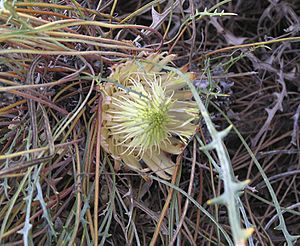Banksia rufa facts for kids
Quick facts for kids Banksia rufa |
|
|---|---|
 |
|
| Banksia rufa near Tarin Rock | |
| Scientific classification | |
| Genus: |
Banksia
|
| Species: |
rufa
|
| Synonyms | |
|
|
Banksia rufa is a type of low-growing bush that spreads along the ground. It is found only in the south-west part of Western Australia. This plant has long, narrow leaves with many deep cuts or lobes on the sides. Its flowers are yellow, orange, or brownish and grow in groups of 40 or more. After flowering, it produces smooth, egg-shaped seed pods.
Contents
What Banksia rufa Looks Like
Banksia rufa is usually a low-growing shrub, but it can sometimes grow up to 1 meter (about 3 feet) tall. It often forms a special woody swelling underground called a lignotuber. This helps the plant regrow after fires.
Its stems are short, have many branches, and are covered in soft, woolly hairs. The leaves are long and somewhat wide, measuring 80 to 350 millimeters (about 3 to 14 inches) long and 7 to 30 millimeters (about 0.3 to 1.2 inches) wide. Each leaf has a stalk up to 150 millimeters (about 6 inches) long. On each side of the leaves, there are between five and twenty sharp, pointed lobes.
The flowers are creamy yellow, orange, or brownish. They grow in heads that contain between 40 and 115 individual flowers. At the base of each flower head are special leaves called involucral bracts, which are 35 to 66 millimeters (about 1.4 to 2.6 inches) long. The flower parts that surround the reproductive organs (called the perianth) are 27 to 50 millimeters (about 1.1 to 2 inches) long. The female part of the flower (the pistil) is 30 to 66 millimeters (about 1.2 to 2.6 inches) long and gently curved.
Banksia rufa usually flowers from July to September. After flowering, it produces egg-shaped seed pods, called follicles, which are 12 to 15 millimeters (about 0.5 to 0.6 inches) long and smooth, meaning they have no hairs.
How Banksia rufa Got Its Name
This plant was first officially described in 1855 by a scientist named Carl Meissner. He called it Dryandra ferruginea. The plant samples he used were collected by James Drummond.
Over the years, the plant's name changed a few times as scientists learned more about it. In 2007, a big change happened. All species that were once in the group Dryandra were moved into the Banksia group by scientists Austin Mast and Kevin Thiele.
Because there was already a plant named Banksia ferruginea, they had to give this plant a new name. They chose Banksia rufa. The second part of its scientific name, rufa, comes from a Latin word meaning "reddish," likely referring to the color of some parts of the plant or its flowers.
Scientists have also identified different types of Banksia rufa, called subspecies. These subspecies have slight differences in their size, leaf shape, or where they grow. Here are a few examples:
- Banksia rufa subsp. chelomacarpa has stems that lie flat on the ground and shorter leaves.
- Banksia rufa subsp. magna grows upright and has longer special leaves at the base of its flowers. It is found near Nyabing and Dumbleyung.
- Banksia rufa subsp. rufa also grows upright and has longer leaves. It is found in areas like Wickepin to Nyabing and Lake Grace.
- Banksia rufa subsp. tutanningensis is similar to some other upright subspecies but has even longer special leaves and a longer pistil. It grows south-east of Pingelly and east of Quairading.
Where Banksia rufa Lives
Banksia rufa is found across a wide area in Western Australia. It grows between Pingelly, the Stirling Range, and Forrestania. You can find it in shrubland and kwongan, which are types of bushland areas. It is often quite common in these places.
Is Banksia rufa Endangered?
The main species, Banksia rufa, and its subspecies rufa are considered "not threatened" by the Western Australian Government's Department of Parks and Wildlife. However, some of the other subspecies have a "priority rating," which means they are being watched closely because they might be at risk in the future.

